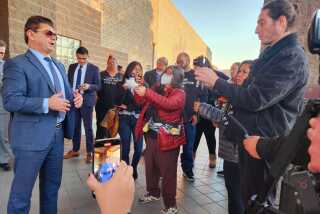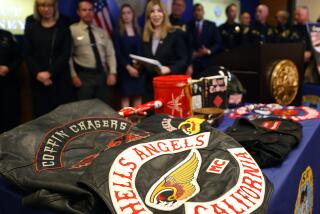Lawyers Assail Conspiracy Idea in Riot Murder Case : Courts: Attorneys for three accused of killing motorcyclist call the prosecutor’s theory an attempt to bypass the requirements for proving the suspects were guilty.
Attorneys representing three men accused of murdering a Long Beach motorcyclist on the second day of the spring riots criticized a prosecutor’s theory that the killing was the result of a conspiracy among gang members at a nearby park to loot, rob and assault people.
Defense attorney Donald Herzstein called the conspiracy charge “a red herring . . . a bootstrap to bypass the normal requirements” to prove that the defendants were linked to the murder of the motorcyclist.
“Anyone who was in the park who looted would be liable, under these bootstraps, for murder,” he said.
Matthew Haines, 32, was yanked off his motorcycle and shot to death April 30. Haines--who was on the bike with his nephew, Scott Coleman--died of a gunshot wound to the neck.
Fabian Nixon, 19, Larry Williams, 24, and Brent Lamar Jones, 17, are charged with murder, robbery, burglary, assault and conspiracy to commit these crimes in Haines’ death.
“The evidence clearly indicates that the reason they left the park was to rob, commit burglary and beat up people,” Deputy Dist. Atty. Joe Markus said in closing arguments in the trial of the three men, the first riot-related murder case to be heard by a jury.
But in closing arguments, defense attorneys said the prosecution had presented no evidence proving that any of the defendants shot Haines.
Moreover, they said, Haines’ death was not part of a conspiracy initiated at Martin Luther King Park.
Herzstein, who represents Nixon, said that people angry over the not-guilty verdicts in the Rodney G. King case “protested, gathered in parks, looted, burned, killed.”
“These were acts of individual people,” he said. “Conspiracy is a rational, thoughtful, intentional act. Rage is not.”
To convict the men on the conspiracy charge, the jury must determine that the defendants agreed to violate the law and that Haines’ death was a direct consequence. To convict them of all charges, the jury must find that they participated in a robbery and that Haines was killed as a result.
“You can’t beat someone (in connection with a robbery) and leave them there,” Markus argued. “If they die, you are guilty of murder.”
Markus told the jury that the incident began when Nixon threw a tire rim at the motorcycle.
Herzstein countered that Nixon threw the rim but missed the bike. Nixon was standing too far from the cycle to hit it with a 30- to 40-pound tire rim, he said.
Markus said police saw Williams shooting a gun in front of an auto parts store just before Haines was shot. Williams had purchased a .380-caliber handgun earlier that day, he said. Bullet casings found in front of the story could have been fired from a .380-caliber weapon, Markus said. The casings matched at least one found across the street from the murder scene, he said.
But Michael McGuire, who represents Williams, said a ballistics expert testified that the bullets recovered from the scene could not have come from the gun Williams is accused of having.
“Nobody saw Larry Williams at the scene of the murder with a gun at all,” McGuire said. He added that Williams was never seen at the park and thus could not have been part of any conspiracy.
However, the prosecutor told the jury that Williams and Jones were among a group of people seen beating and kicking Haines and standing over his body on the sidewalk.
“You wouldn’t have been standing over the bodies of the victims unless you were part of beating and robbing them,” Markus said.
Defense attorneys accused police of not thoroughly investigating Haines’ death.
More to Read
Sign up for Essential California
The most important California stories and recommendations in your inbox every morning.
You may occasionally receive promotional content from the Los Angeles Times.










